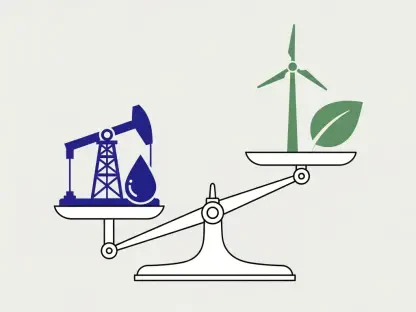The upcoming changes to the National Australian Built Environment Rating System (NABERS) Energy ratings are set to pose significant challenges for Australian office buildings. These properties, particularly those heavily reliant on natural gas, could see a substantial negative impact on their energy efficiency ratings, potentially diminishing their market value. This shift in rating methodology, scheduled to take effect in July of the following year, introduces new complexities for property owners and the commercial real estate market. As Australia moves toward greener and more sustainable buildings, the importance of understanding and adapting to these changes cannot be overstated.
The Impact of NABERS Rating Changes on Office Buildings
The NABERS Energy rating system, which ranges from one to six stars, is a critical measure of energy efficiency for office buildings in Australia. With six stars representing market-leading performance, the rating is mandatory for any office building larger than 1,000 square meters when sold or leased. Despite an increase in renewable energy usage, a significant 68 percent of NABERS-rated office buildings still depend on natural gas, according to Knight Frank’s analysis. As these energy sources face harsher scrutiny, buildings not transitioning to renewable energy sources may find themselves at a substantial disadvantage in the market.
Buildings that rely heavily on natural gas for their energy needs are most vulnerable to the upcoming rating changes. Office buildings in colder states, such as Victoria and the Australian Capital Territory (ACT), are expected to be severely affected due to their heavy reliance on gas for heating. In contrast, warmer regions like the Northern Territory, which have limited reliance on gas, are less likely to be significantly impacted. The disparity in the impact underscores the regional challenges that property owners will need to consider when planning upgrades and changes to meet the new rating criteria.
Regional Disparities in Energy Consumption
Knight Frank’s data reveals that 11 percent of the 851 NABERS-rated gas-consuming buildings cover more than 10,000 square meters and consume over 50 percent of their energy on-site as gas. This means that larger assets in colder markets like Victoria and ACT face greater challenges in moving towards electrification and away from gas reliance, forcing owners to explore new technologies and energy sources more aggressively. The need for comprehensive strategies to mitigate the shift in energy consumption patterns is evident as these regions adjust to the new realities.
David Bullock, Knight Frank’s Director of ESG, emphasized the necessity for electrification in larger buildings, particularly in colder climates. While renewable energy is gaining traction, many properties still require significant upgrades to enhance their energy efficiency and reduce gas reliance. The ACT is expected to experience the most substantial impact, with 92 percent of buildings likely to see a drop in their NABERS Energy rating, followed by Victoria at 90 percent, South Australia at 89 percent, and New South Wales at 72 percent. The Northern Territory stands apart with only five percent of its buildings using gas, thus facing minimal impact from the rating change. These statistics illustrate the significant variation across Australia and the critical need for tailored strategies to address regional energy challenges.
Consequences for Building Ratings and Market Value
Jenine Cranston, head of ESG at Knight Frank, explained that buildings with higher gas consumption would see a lower energy rating outcome starting from 2025. Buildings using gas predominantly for heating could anticipate a reduction of about 0.5 stars in their NABERS Energy rating by 2025 and one full star by 2030. However, buildings using gas solely for domestic hot water are likely to experience only minimal impact. This poses a nuanced challenge for building owners to understand their specific energy usage and make informed decisions on necessary adjustments and investments.
Cranston warned that buildings barely meeting their current energy ratings are almost guaranteed to see a drop post-2025, assuming no improvements are made. This downgrade in energy ratings could concurrently lead to a reduction in asset value, as environmentally sustainable assets are increasingly in demand among buyers. A building’s energy rating significantly influences its market appeal, with lower ratings steering away ESG-conscious tenants and investors. This potential depreciation emphasizes the urgency for property owners to proactively address the changes and maintain their market competitiveness.
Challenges for Older and Newer Buildings
Both newer and older buildings are affected by these changes. Many older office towers still operate on fossil-fuel-powered heating systems and outdated cooling mechanisms, making them less energy-efficient. These properties, alongside barely-electrified newer buildings, require immediate attention and upgrades to maintain their market competitiveness and tenant appeal. Addressing these issues may involve substantial investments in modernizing infrastructure and adopting cleaner energy sources, which can be both costly and time-consuming.
Cranston urged property owners to proactively consider how the changes will affect their buildings and to take action now. She outlined that ESG (Environmental, Social, and Governance) is a rapidly evolving sector. Keeping up with its complexities can be challenging, and seeking expert guidance is advisable for navigating these changes effectively. Cranston advised that to future-proof properties, owners should develop and implement electrification plans rather than merely having them on paper. Buildings are rated on performance over the previous 12 months, and having an incomplete electrification plan will not suffice under the new NABERS Energy rating criteria. This proactive approach ensures buildings can remain competitive and appealing to prospective tenants and investors.
Proactive Steps Towards Sustainability
The forthcoming modifications to the National Australian Built Environment Rating System (NABERS) Energy ratings are poised to present considerable challenges for Australian office buildings. Those structures that heavily depend on natural gas might experience a significant adverse impact on their energy efficiency scores, which could in turn lower their market values. This revision in the rating methodology is slated to be implemented in July of the next year, adding new layers of complexity for property owners and the commercial real estate market. As Australia pushes towards greener and more sustainable buildings, grasping and adapting to these new changes becomes crucial. The update in NABERS ratings reflects a broader effort to reduce carbon footprints and promote environmental responsibility across the real estate sector. Property owners will need to investigate alternative energy sources and invest in upgrades to maintain or enhance their ratings. Overall, the understanding and proactive response to these changes are essential for sustaining property values and contributing to a more sustainable future.









